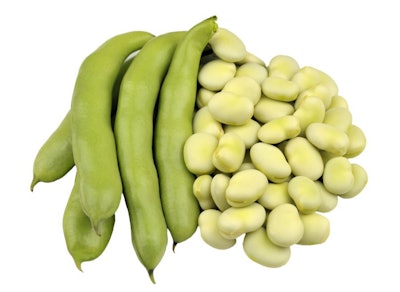
Study: Replacing soybeans with broad beans in poultry diets a viable soy-free solution for the EU
German researchers looking to boost regional independence and sustainability say they have found a possible soy-free poultry diet using locally grown broad beans.
Meat products from a traditional German breed of chicken showed no difference whether the birds consumed a conventional soy-based diet, or a diet containing a blend of broad beans, peas and other locally produced proteins, according to a new study published in the journal Foods. Eggs produced by the same breed of chickens, a dual-purpose breed suitable to egg and meat production, were only slightly smaller on the broad bean diet.
The study was part of an ongoing effort to boost agricultural independence and increase sustainability by decreasing dependence on imported soybeans, according to Daniel Mörlein, a professor and head of the animal product quality group at the University of Göttingen.
“This type of beans is very suitable for this region,” said Cynthia Escobedo del Bosque, the lead author of the paper and a doctoral candidate at the University of Göttingen. “Our main focus was to replace soy with these broad beans, because the farmers can actually produce them here.”
Broad beans have been used in animal feed in the past, Mörlein said, but the beans’ high lysine content raised concern among producers that it would impair the health and growth of animals raised on large quantities of the beans. This study, he said, demonstrates this isn’t necessarily the case.
However, some barriers remain, including the fact that the beans are not produced in quantities sufficient to support widespread use in commercial animal feed, Mörlein said. Despite the need to import soybeans, the staple ingredient is cheaper than the regionally grown broad beans. He said further research would be necessary to determine if broad beans would be cost competitive at scale.
Combined with the dual-purpose chickens included in the study, the broad bean-based diet may always remain a niche product, Escobedo del Bosque said. She is focused on market research to determine if there might be sufficient demand for a locally produced, soy-free chicken product to support a higher price, but so far she believes there is a place for the broad bean product.
“There is a consumer niche that would be willing to pay — not as much as for organic products, but higher than what they would pay for conventional,” she said, pointing to surveys that asked consumers about hypothetical purchases of products with different origin, feed origin, and breed. “We found the most important factor beside price is product origin.”
Reducing or eliminating soy from poultry diets could also become more important in the future, Mörlein said, given rising consumer concern about the environmental impacts of soy, and the potential for increased labeling of products that contain soy or that are not certified deforestation-free.















